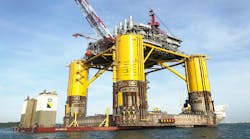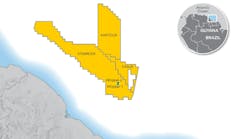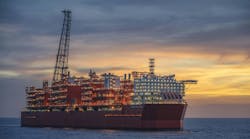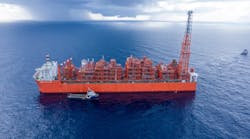Manuel R. Suarez
Kumana & Associates
Large amounts of oil and gas reserves are in remote offshore locations. Oil is normally produced offshore and transported to onshore process facilities via pipelines or FPSO vessels. Oil processing units are often located in coastal areas; however, their characteristics preclude any considerations of moving them offshore. Gas on the other hand, depending mainly on volume, distance to processing facilities, and expected production life of the reservoir could be transported to shore or processed offshore in fixed facilities (platforms) or in floating units.
New technologies allow some processes to be moved offshore where gas volumes previously flared or re-injected can now be processed economically.
A clear trend in the near future is for more gas processes to move offshore. With LNG already a reality in fixed or floating units, the question is which process will move next. An obvious candidate is Gas-To-Liquids (GTL), originally conceived for applications with stranded gas streams that could not very well be processed and sent to markets. Advantages include no cryogenics, no high pressures, simply come out of the field with market-ready liquid products.
Some of the essential characteristics that processes should have to be feasible offshore are scalability and modular unit configuration (not just "modularized" construction). In the case of floating units, an additional requirement is flexibility with respect to the feed gas to allow the unit to operate in different fields.
Three options for GTL have been successfully implemented in commercial scale onshore: Fischer-Tropsch (FT), methanol to gasoline (MTG), and single loop syngas to gasoline (STG).
Of the three, only STG meets all the offshore requirements. FT and to some extent MTG still need work to develop economically feasible small-scale units. STG produces syngas via steam methane reforming (SMR) and is cost effective in scales as low as 6,000 b/d of final product: 90+ octane gasoline. There are STG units suitable for flared gas in the 500 to 2,000 b/d range of product.
Offshore processes
The chemistry and therefore the basic control strategy and operational philosophy of a given process are essentially the same in onshore and offshore environments. However, a key difference is the lower tolerance for incidents in offshore units. This results in more demanding operating and maintenance standards where environmental liability risks and high mitigation costs can well preclude moving certain processes offshore.
Offshore is essentially the same as facilities in coastal regions where oil and gas facilities are common. The tilt and motion-induced vibration in floating units may require attention in some areas like special bearings in rotating equipment and operating conditions in process equipment involving liquid-liquid or vapor-liquid contact (e.g., scrubbers, absorption, distillation towers).
Blow downs and emergency dumping of vessels (e.g., reactors) have to be carefully examined and avoided if possible. To make provisions for them in offshore facilities where space is severely limited is expensive and may not be possible.
Best practices
Consider this incident in an onshore site. In Fischer-Tropsch processes hydrogen is produced by the "water gas shift" reaction: H2 + CO + H2O = 2H2 + CO2 (1). During the startup of one of these units at an Eastern European refinery, as reformed gas feed reached the adiabatic shift reactor, the steam flow meter suddenly dropped to zero and soon after the temperature readings in the bottom section of the reactor started to get abnormally high. An instrument specialist was sent to check the steam flow meter and to replace the high-reading thermocouples. With zero steam flow, the perceived heat source, the temperature could not be going up.
When the specialist reached the reactor, saw that the bottom insulation had fallen off and a red-hot bulge was visible in the night. The flow meter and the thermocouples readings were all correct. With no water (steam) flow, reaction (1) is replaced by the highly exothermic methanation reaction: 3H2 + CO = CH4 + H2O (2).
The startup was delayed for months and the losses aggravated by site clean up and major equipment replacements.
Had this taken place offshore, the losses would have been much higher. In an offshore setup, any incident likely to put a hole in the factory floor is sure to put a much bigger one in the venture's bottom line.
Some of the practices that should have prevented this incident are very much the same as those required to successfully move and operate processes offshore:
- Adequate interdisciplinary training for engineers, operators, and maintenance technicians in the four main branches: electrical and instrumentation, chemical engineering, mechanical engineering, and electrical engineering. This is just core engineering knowledge not "onshore" or "offshore" specific.
- Process design by multi-disciplinary team including operational philosophy narrative, control strategy, procedures, and safety issues associated with each process step.
Shamefully enough, this is not happening as it should.
In industry, an indication that the process control was left entirely to E&I with little or no input from process engineering is the over-abundance of alarms and interlocks, some times to the point of seriously impairing proper operation. This is observed in various offshore facilities and many onshore facilities.
- Beware of "easy" solutions with tools for process design (e.g., dynamic simulation, hardware-in-the-loop, safety packages, auto-configured alarm systems, etc.) that claim to be almost plug-and-play/no experience required. They are usually excellent tools but tools only, not a replacement for solid core engineering knowledge.
Also, when moving a process from onshore to offshore, be specially aware if the process uses standard, pre-engineered equipment designed for oil and gas onshore operations that may not be suitable for offshore. If so, instead of a savings, a hidden flaw would be introduced in the design.
And especially offshore, with water all around, the hidden flaw seldom remains hidden.




